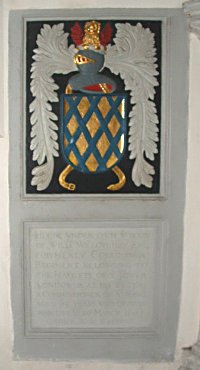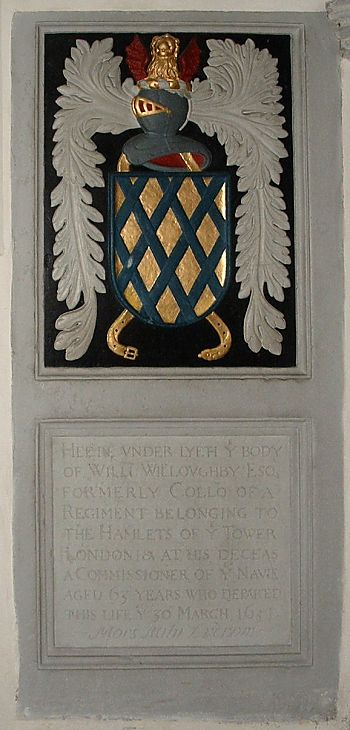Location
On the South wall of St. Thomas's Chapel (see Cathedral Plan).
OF WILLI WILLOUGHBY ESQ.
FORMERLY COLLO OF A
REGIMENT BELONGING TO
THE HAMLETS OF YE TOWER
(LONDON) & AT HIS DECEAS
A COMMISSIONER OF YE NAVIE
AGED 63 YEARS WHO DEPARTED
THIS LIFE YE 30TH MARCH 1651
Further Information
William Willoughby's memorial stands adjacent to a similar stone in the memory of Robert Moulton which is fitting since these men were considered to be to be founders of Portsmouth Dockyard ('Portsmouth Parish Church' by Lilley and Everitt).
William Willoughby (also known as William Willowbey and William Willobye) was born c1588 and married Elizabeth Wouller on 3 November, 1614 at Stepney, St. Dunstan, Middlesex. His parentage has not been established though several inaccurate reports have been circulated, notably that he was the son of Christopher Willoughby (c1559-1631) of Penshurst, Kent by his wife Martha. It is known however that he was a member of the Willoughbys of Eresby, whose arms appear on the memorial.
In 1614 William Willoughby was known to be a mariner of Limehouse, Stepney, St. Dunstan, Middlesex and by 1625 he was a shipwright giving the same address. By 1643, with the Civil War under way, he was a Captain in a Company of the Trained-Bands belonging to the Tower and in April that year raised a 100 stout youngsters as Volunteer Auxiliaries to the Trained-Bands of the City. This was the beginning of the "Yellow" Auxiliaries of which he was later made Colonel.
For the next five years Willoughby fought with the Auxiliaries at places such as Basing, Alton, Alresford and Abingdon. In 1648, he and others were appointed to the Committee for the Militia of the Tower Hamlets. Shortly thereafter a portion of the Navy revolted at which a Council of War declared that a great Fleet should be provided for Parliament; Willoughby was employed as a Commissioner of the Navy at Portsmouth and given a house called Chapel Fields (South of Armoury Lane). He remained in this position until his death three years later.
See the History in Portsmouth website for more information


